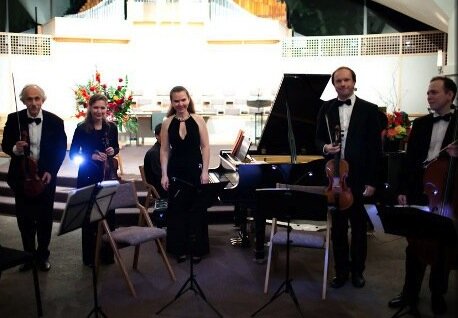
Not everyone wants to go to a formal classical music concert in a concert hall, or make a big evening of it. Some newcomers to the genre might find the idea more than they want to commit to or too much effort, others would like to introduce a kid to this kind of live music and these kinds of instruments.
Don’t despair! Here in Seattle we have a plethora of terrific musicians who perform outside as well as inside the symphony, the opera, the ballet or the theater; in churches, community halls, cafes and other places in the neighborhoods easy to get to, less expensive and you don’t have to dress up. And the concerts are often informal and shorter.
One such performance took place Friday night at Mercer Island Presbyterian Church, the first in its own concert season of eight concerts, the first of the season for Seattle Violin Virtuosi, and the first of the season’s offerings from the Russian Chamber Music Foundation. (Find more of their offerings, including an October 14 concert, here.)
It was just an hour long with brief and often humorous remarks introducing short pieces of music arranged for the instruments at hand, but that didn’t make the actual performances less than thoroughly professional and a pleasure to hear.
Five violinists performed from the Virtuosi, led by Michael Miropolsky (more often seen on the first stand of the second violins in the Seattle Symphony) with his colleague in that section, Artur Girsky; Brittany Boulding, excellent concertmaster of the Auburn Symphony and also a member of the Magical Strings family; and Eugene and Natasha Bazhanov, frequent performers with the symphony, ballet, and more.
They were accompanied by pianist Deborah Dewey of Ventidita, who also joined with pianist Natalya Ageyeva, artistic director of the Russian Chamber Music Foundation, to play several pieces with four hands-one piano (as they pointed out, one was for just three hands).
All of the composers were Russian, as befits the mission of the Foundation, with many familiar exerpts from works by Prokofiev, Mussorgsky, Shostakovich, Rimsky-Korsakov, Rachmaninov (of course), and Katchaturian. Most were upbeat and cheerful, even the familiar Spanish Dance of Shostakovich which lacked any of the angst so often underlying his music.
Every piece had been arranged, sometimes multiple times for a myriad different instruments, so these performers had no hesitation in bringing these works more often heard in different guise to an intimate audience who could hear and see performers and instruments close up.
Several works were played by the five violinists with piano, but Miropolsky, Girsky, and Dewey performed a charming group of Shostakovich miniatures, while Dewey and Ageyeva played together a variety of piano pieces including the very familiar Flight of the Bumblebee by Rimsky-Korsakov.
The acoustics of this modern Presbyterian Church are probably excellent for speech, but not generous to musicians. There was little acoustical warmth to surround, soften or enhance musical resonance, so that at times the violins sounded on the shrill side and the piano a little bit on the percussive side, but these were analytical quibbles in what was after all, a lighthearted and delightful evening of music at the very end of summer.